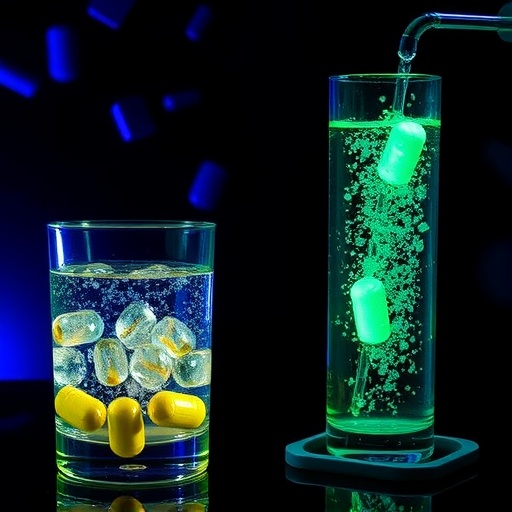A groundbreaking study has emerged from the prestigious Chinese Journal of Catalysis, presenting a cutting-edge solution in the battle against water pollution—an innovative S-scheme heterojunction photocatalyst capable of effectively degrading antibiotic contaminants in water. This remarkable photocatalyst, composed of manganese-cadmium sulfide (Mn0.5Cd0.5S) and indium sulfide (In2S3), promises not only to enhance water purity but also to significantly reduce the toxicity of byproducts that arise from the degradation of these harmful compounds.
The increasing prevalence of antibiotics in aquatic environments poses a dire threat to public health and ecosystems. With substances like tetracycline hydrochloride (TCH) commonly used in both human and veterinary medicine, improper disposal practices have led to their alarming accumulation in water bodies. These pollutants not only contribute to the growing issue of antibiotic resistance but also harm aquatic life, creating an urgent need for advanced treatment methods that can effectively eliminate these contaminants while adhering to safety standards.
Traditional water purification techniques often fall short in removing persistent antibiotic pollutants. While photocatalytic methods have shown promise through advanced oxidation processes, they frequently encounter the problem of rapid recombination of photogenerated charge carriers. This study effectively addresses this pivotal challenge by presenting a novel S-scheme heterojunction photocatalyst that utilizes Mn0.5Cd0.5S/In2S3, leveraging a mechanism that enhances charge separation and boosts photocatalytic efficiency.
In this innovative photocatalyst design, an internal electric field is created at the interface of the materials, directing the flow of excited electrons and holes. This strategic configuration not only facilitates superior charge separation but also markedly increases the material’s photocatalytic activity. The remarkable result saw the composite degrading TCH at a rate 4.85 times faster than the catalyst’s individual components—a clear indication of its enhanced efficacy.
Extensive practical tests have confirmed the robustness of this S-scheme photocatalyst, demonstrating high degradation efficiency across a range of natural water sources including seawater, river water, and tap water. The catalyst displayed impressive resistance to various inorganic anions, demonstrating its versatility and potential for real-world applications in diverse water treatment scenarios. Furthermore, the study included a substantial evaluation of its performance within a continuous-flow treatment system that employed a polyvinylidene fluoride (PVDF) membrane, illustrating the catalyst’s long-term stability, operative effectively for over 48 hours.
One of the standout features of this research is its commitment to environmental safety. The team deployed toxicity estimation software and conducted bioassays involving Escherichia coli and mung beans to ascertain the potential hazards of the degradation intermediates. Their findings revealed that the antibiotic breakdown products generated during the photocatalytic process were significantly less harmful compared to the original contaminants, with toxicity levels becoming negligible following treatment. This is a crucial advancement in ensuring that purification technologies not only clean water but also do so without introducing new environmental risks.
The implications of such innovative research reach far beyond mere water purification. This study encapsulates a comprehensive strategy extending from material design through to practical deployment and environmental impact assessment, a significant step forward in the ongoing quest for sustainable photocatalytic technologies tailored for effective water management.
As urbanization and industrial activities continue to escalate, the development of efficient water purification methods has never been more critical. With the rise of antibiotic-resistant bacteria and the increasing prevalence of waterborne diseases, the implementation of advanced technologies like the S-scheme photocatalyst offers a beacon of hope in the global effort to protect water resources. This research paves the way for more refined approaches to combatting contamination, promoting not only a cleaner environment but also a healthier population.
The scholarly community is likely to dissect the findings of this research and explore additional areas for future inquiry, including investigating other potential applications for the S-scheme photocatalyst in different environmental contexts. It presents a tantalizing glimpse into the future of water treatment technology, where photocatalysis could play a central role in ensuring safer, cleaner water for generations to come.
Collaboration between scientific institutions and industrial partners will be essential in translating these laboratory successes into practical solutions for communities worldwide. Building a bridge between innovative research and practical application will foster the deployment of such technologies in real-world scenarios, ultimately leading to an enhanced quality of life as water safety is prioritized.
In summary, this cutting-edge research signifies a promising development in the realm of environmental science and technology, offering a sustainable, effective strategy for mitigating antibiotic contamination in water bodies. Such breakthroughs are vital not only for the progress of scientific knowledge but also for addressing pressing public health challenges—a true testament to the importance of continued investment and investigation in the field of environmental remediation through advanced photochemical techniques.
Subject of Research: Development of an S-scheme photocatalyst for the degradation of antibiotic pollutants in water.
Article Title: Systematic assessment of emerging contaminants elimination using an S-scheme Mn0.5Cd0.5S/In2S3 photocatalyst: Degradation pathways, toxicity evaluation and mechanistic analysis.
News Publication Date: 6-Aug-2025.
Web References: Chinese Journal of Catalysis, DOI.
References: 10.1016/S1872-2067(25)64723-1.
Image Credits: Credit to the Chinese Journal of Catalysis.
Keywords
Tags: advanced water treatment methodsantibiotic resistance in aquatic environmentsantibiotic-contaminated water purificationdegradation of tetracycline hydrochlorideenvironmental impact of antibioticsindium sulfide heterojunctioninnovative water purification solutionsmanganese-cadmium sulfidephotocatalytic degradation of pollutantsreduced toxicity of byproductsS-scheme photocatalystwater pollution and public health





